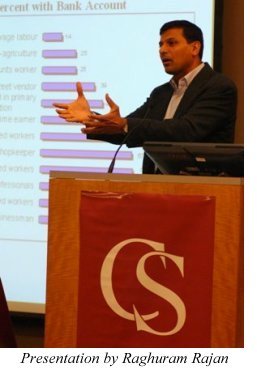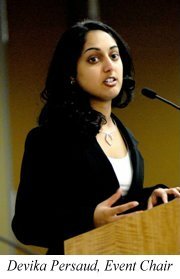| | “Credit for the Poor: Fighting Poverty with Microfinance in India”

Raghuram Rajan, Steve Rasmussen, Raven Smith, Sheel Mohnot, and Saurabh Narain
April 2008––Grameen Bank opened up new credit possibilities for the poor globally. Microfinance became the tool with which the world could fight poverty and help people escape their $1/day lifestyles, but this panel event addressed the dangers in treating microfinance as a panacea to cure all social and economic problems.
Moderator Saurabh Narain of Shorebank asserted that microfinance is, at its core, the same concept as American-style community finance. Thus, microfinance is not something that is merely applicable to less-developed countries; in fact, it has a direct analog here in the United States as well. He directed the following question to the panelists, focused specifically on India: what can we do from an organizational perspective to achieve sustainable growth?
Steve Rasmussen of the World Bank gave a brief overview of the microfinance banking structures currently in place in India. Self Help Group (SHG) Bank Linkage programs allow NGOs to give loans in small amounts to poor rural women, which is a demographic group that has been traditionally underserved by conventional banking systems in India. Large microfinance institutions (MFIs), on the other hand, are typically more concerned with spreading money to a large swath of people, especially small-business owners. Finally, branchless banking appears to be the next big breakthrough for Indian banking and microfinance, because it allows people to make financial transactions via their cell phones. Cell phones are used by a large portion of the Indian populace, including many people in rural areas who would find it difficult to travel to the closest major bank in order to make transactions. Thus, the advent of branchless and mobile banking might drastically increase the ability of conventional banks to reach out to rural and poor citizens.
Sheel Mohnot of KIVA explained how online organizations like KIVA work – by matching donors with specific recipients (as opposed to merely forcing donors to give money to the organization), KIVA is able to better encourage individuals to give money to microfinance causes. Furthermore, because KIVA is not a complete banking system, its partnerships with local MFIs help new MFIs become established lenders. Furthermore, Mr. Mohnot touched on the fact that legal issues in India have barred KIVA from becoming an “eligible borrower,” which would make it easier for the organization to invest money directly in India.
Raven Smith of AIG made the point that traditional microfinance institutions are oftentimes overly concerned with giving money to entrepreneurs, which means that people who simply want a steady job are neglected. Thus, groups like BASIX try to lend money to somewhat well-developed companies so that these companies can hire more local workers.
 Professor Raghuram Rajan of the Chicago GSB made the argument that microfinance is simply one tool that can be used to rectify wide-scale poverty in India, and that it is important to consider revamping the entire banking system. Since there is an artificial ceiling on interest rates for loans in India, banks are unable to give loans to poor people, who tend to only take loans when they have urgent needs in times of sickness or family crisis. Because of this artificial ceiling, around 75% of Indians borrow money from family/friends and local moneylenders with whom they have a personal relationship. Unfortunately, these systems of borrowing money are oftentimes accompanied by a very high interest rate. The government has tried to rectify this problem by establishing schemes that lend money at low interest rates, but audits have shown that this system oftentimes leads to rampant bribery. After giving this summary of the banking situation in India, Professor Rajan then gave his suggestions for rectifying the problems: people should be encouraged to have savings accounts so that they can build up a relationship with traditional banks and so that they have money saved up in case of an emergency, the government should expand the number of banking licenses so that smaller banks can enter the economy and provide loans to the poor and the underserved, technologies like branchless cell phone banking should be utilized to the fullest extent, and the current rules on interest rates for bank loans should be relaxed. Professor Raghuram Rajan of the Chicago GSB made the argument that microfinance is simply one tool that can be used to rectify wide-scale poverty in India, and that it is important to consider revamping the entire banking system. Since there is an artificial ceiling on interest rates for loans in India, banks are unable to give loans to poor people, who tend to only take loans when they have urgent needs in times of sickness or family crisis. Because of this artificial ceiling, around 75% of Indians borrow money from family/friends and local moneylenders with whom they have a personal relationship. Unfortunately, these systems of borrowing money are oftentimes accompanied by a very high interest rate. The government has tried to rectify this problem by establishing schemes that lend money at low interest rates, but audits have shown that this system oftentimes leads to rampant bribery. After giving this summary of the banking situation in India, Professor Rajan then gave his suggestions for rectifying the problems: people should be encouraged to have savings accounts so that they can build up a relationship with traditional banks and so that they have money saved up in case of an emergency, the government should expand the number of banking licenses so that smaller banks can enter the economy and provide loans to the poor and the underserved, technologies like branchless cell phone banking should be utilized to the fullest extent, and the current rules on interest rates for bank loans should be relaxed.
 The question-and-answer period yielded questions on a wide variety of topics. On the topic of Islamic banking, the panelists generally agreed that the Islamic religious restrictions on charging interest for a loan did not heavily impact the banking situation in India, and that there were relatively straight-forward ways for banks to circumvent these restrictions. On the topic of micro-health efforts, Mr. Rasmussen and Ms. Smith both mentioned that multiple communities in India had initiated a community-based health care system that allowed local residents to bypass the large state-run hospital system. Finally, on the topic of increasing the effectiveness of microfinance, Professor Rajan and Mr. Rasmussen both agreed that in terms of wide reach, the postal service had the largest reach of any corporation or entity in India. Professor Rajan also mentioned that financial institutions should consider making alliances with the postal service so that they could enjoy a similar reach into rural areas. The question-and-answer period yielded questions on a wide variety of topics. On the topic of Islamic banking, the panelists generally agreed that the Islamic religious restrictions on charging interest for a loan did not heavily impact the banking situation in India, and that there were relatively straight-forward ways for banks to circumvent these restrictions. On the topic of micro-health efforts, Mr. Rasmussen and Ms. Smith both mentioned that multiple communities in India had initiated a community-based health care system that allowed local residents to bypass the large state-run hospital system. Finally, on the topic of increasing the effectiveness of microfinance, Professor Rajan and Mr. Rasmussen both agreed that in terms of wide reach, the postal service had the largest reach of any corporation or entity in India. Professor Rajan also mentioned that financial institutions should consider making alliances with the postal service so that they could enjoy a similar reach into rural areas.
Event Planning Committee:
- Devika Persaud (Chair)
- Simha Mummalaneni
- Divya Sundar
- Sree Kode
- Lane McIntosh
- Abhishek Jha
Event poster:

Return to Past Events Page
|
|

